

 |

|
Broadway Corridor Rapid Transit Options
Results of a Public Opinion Poll
With Vancouver ResidentsExecutive Summary
Executive Summary of Broadway Rapid Transit Poll
i. Research Objectives & Methodology
As part of the public consultation process regarding rapid transit along Broadway, MarkTrend Research was retained to conduct a public opinion survey among Vancouver residents. The primary objective of the research is to determine what type of transit Vancouverites prefer and what concerns they may have regarding the impact of each type.
A three-phased approach was taken where residents were randomly recruited, sent an information package and then called back to conduct a follow-up survey. In total, 503 interviews were completed. Of these, 303 were part of a random sample of all Vancouver residents, while 200 were part of an oversample of residents living in the Broadway corridor, which was defined as 6 blocks on either side of Broadway. At the data analysis stage, the oversample results were weighted back to its correct proportion to ensure that the total results are representative of all Vancouver residents.
ii. Summary of Findings
Resident Priorities for Selecting a Rapid Transit Option
To help understand the factors that drive preferences when it comes to selecting a rapid transit option for the Broadway corridor, Vancouver residents were asked what they consider most important in a transit “solution”. The poll results suggest there are two areas that residents feel should have the most influence on the decision process: “how well the solution meets long term needs” and “how efficiently it moves riders”. Specifically, at least two-thirds of residents consider it very important (rating of 8-10 out of 10) that the rapid transit option chosen meets long term capacity needs and efficiently gets riders from point A to point B.While cost is a priority for many, it ranks behind these two top concerns in overall importance. As such, it appears that residents would appreciate the added value that comes from an option that may be more expensive initially, but would serve transportation needs more efficiently and for a longer period of time.
These sentiments are consistent among all residents, regardless of whether or not they are current transit riders. Likewise, attitudes are quite consistent for both Broadway corridor resident and those who live in the “rest of the city”.
Meanwhile, residents appear to be least concerned with the effect the rapid transit option will have on on-street parking or its impact during construction. While these two areas are a concern to about one-third of residents, relatively speaking, they hold less importance than the other factors.
Appeal of the Rapid Transit Options
When each option is tested individually, residents show considerably more interest in introducing SkyTrain + RapidBus to the Broadway corridor than using RapidBus only or Light Rail Transit. Indeed, about eight in ten find the SkyTrain + RapidBus option appealing, including one-half who consider it “very appealing”. By comparison, only about one-quarter find either RapidBus or LRT “very appealing”. Again, attitudes are remarkably consistent between those who live in the Broadway corridor and the “rest of the city”.
Evaluation of RapidBus
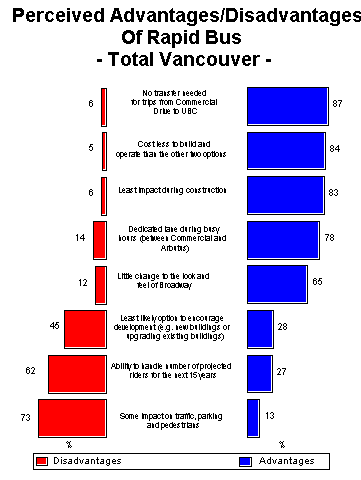 Net Score
Net Score
+81
+79
+77
+64
+53
-17
-35
-60
The major advantages of RapidBus only are seen to be the efficiency aspect of not requiring passengers to transfer between Commercial Drive and UBC, the lower cost in relation to the other two options and the limited impact during construction. On the other hand, the major disadvantages are the impact that RapidBus will have on traffic, parking and pedestrians. Another fairly significant disadvantage is that RapidBus will only be able to handle the number of projected riders for the next 15 years. In terms of making RapidBus more palatable to those who currently find this option unappealing, clearly, these two disadvantages will need to be addressed.
Evaluation of Light Rail Transit
Net Score
+83
+84
+79
+69
+46
+38
-25
-34
-71
-74
-79
-83
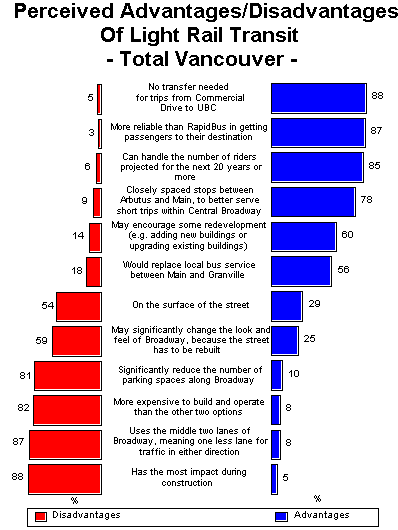
Three major advantages emerge for LRT; the efficiency aspect of not requiring passengers to transfer between Commercial Drive and UBC, the reliability of LRT and its projected 20 year capacity. On the other hand, four major disadvantages emerged; the impact during construction, the utilization of the middle two lanes on Broadway, the cost and the reduction of parking spaces along Broadway. Among those who found LRT unappealing, lowering the cost, reducing the impact on traffic and elevating or putting it underground were the three most common suggestions for making LRT more appealing.
Evaluation of SkyTrain & RapidBus
Net Score
+74
+65
+64
+64
+60
+29
+15
+21
+4
-44
The SkyTrain + RapidBus option is generally considered most appealing because it is considered to have relatively little impact on traffic. Indeed, the three greatest advantages are all tied closely to this theme, with residents appreciating that this option has no direct impact on traffic, has little impact on traffic during construction and will be underground. Notably, residents also seem to appreciate that this option will encourage some redevelopment around SkyTrain stations, but will not necessarily lead to “wholesale” changes along Broadway (most consider it an advantage that it will have minimal impact on the look and feel of Broadway).
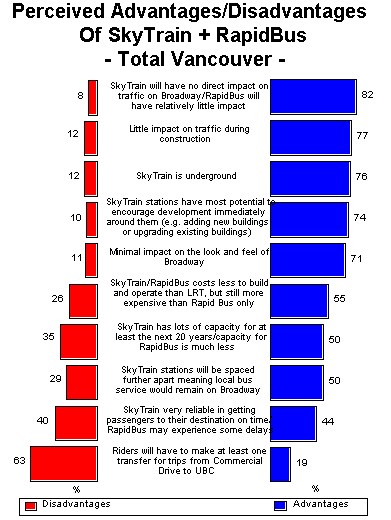 Tellingly, residents feel that the drawbacks of this option are not quite as serious as for LRT or RapidBus only. Overall, the most negative aspect of SkyTrain + RapidBus is that riders will have to transfer between Commercial Dr. and UBC (63% consider this a disadvantage). This is the only factor for this option that is considered a disadvantage by a majority of residents.
Tellingly, residents feel that the drawbacks of this option are not quite as serious as for LRT or RapidBus only. Overall, the most negative aspect of SkyTrain + RapidBus is that riders will have to transfer between Commercial Dr. and UBC (63% consider this a disadvantage). This is the only factor for this option that is considered a disadvantage by a majority of residents.
For many, in fact, it appears the only drawback is that SkyTrain doesn’t extend all the way to UBC. When asked for suggested improvements, fully one-quarter of residents volunteered the suggestion that SkyTrain should be extended to UBC. Some, meanwhile, are concerned with the possibility of crime on the SkyTrain or around stations, as this was mentioned by a number of residents (particularly those along the Broadway corridor).
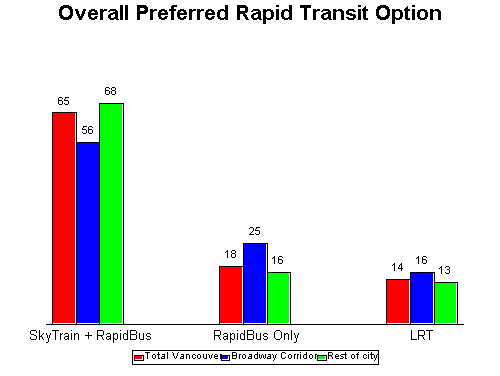
Residents’ desire for a SkyTrain option that extends as far west as possible is clearly demonstrated when they are directly asked which of four termination points they would prefer. Overall, terminating SkyTrain at Arbutus St. is widely preferred over the other three possibilities (Granville St., Cambie St. and Main St.). And, in fact, if the survey had tested the appeal of a termination point even further west, it seems reasonable to imagine that this would have been the preferred option.
Preferred Rapid Transit Option
Overall, the SkyTrain + RapidBus option emerges as the clear favourite of Vancouver residents. Those living in both the Broadway corridor and the “rest of the city” show a strong preference for this option. Opinions are also quite consistent demographically, with SkyTrain + RapidBus the consensus choice of all groups, regardless of age, gender or household income.
Residents strong support for the SkyTrain + RapidBus option appears to be linked to a number of key factors. Firstly, this option is seen to meet the requirement of building a transit “solution” that meets long term capacity and moves riders efficiently. Tied in with this sentiment is the appeal of an option that is consistent with the current (and perhaps future) transportation infrastructure, giving it the impression that it is part of a “larger vision”.
While some also appreciate that SkyTrain + RapidBus is less expensive than LRT, this does not appear to be the crucial difference for most. Instead, the greatest advantage of SkyTrain + RapidBus over LRT appears to be that it will have relatively little impact on traffic and the look and feel of the Broadway corridor. Residents generally seem unwilling to accept the significant changes that LRT would have on the corridor. Perhaps the single greatest barrier for the LRT option is that it would take away the middle two lanes of the street.
The reasons that SkyTrain + RapidBus is generally preferred over RapidBus only are even more clear-cut. Put simply, residents tend to feel that the RapidBus only option is too short-sighted. There is clear demand for an option that will “solve” long-term needs, rather than provide temporary stop-gap measures.
Preferred Rapid Transit Option With Cost as a Primary Consideration
To give residents a clearer picture of relative costs associated with rapid transit, the overall cost to build each option was quoted on a “per-person” basis. While these are approximations, they do provide residents with a more practical means of assessing the relative cost for each option.
Even with the introduction of these per-person costs, however, there is little shift in preferences among residents. Attitudes remain remarkably similar, with a total of 62% continuing to favour the SkyTrain + RapidBus option (a drop of just 3% from its previous level of support). Moreover, even though the Arbutus St. termination point is the most expensive scenario, this continues to be the clear favourite. Again, this suggests that there is some appetite to see SkyTrain extended even further west.
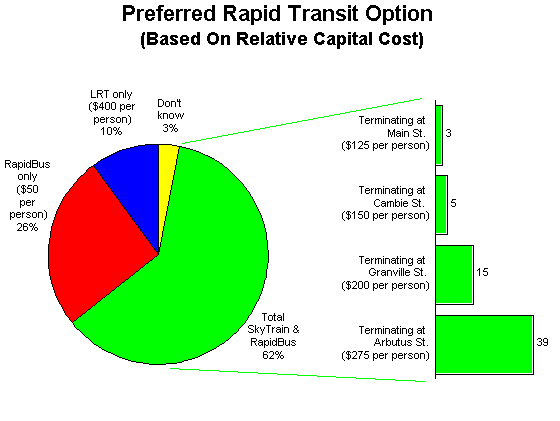
![[City Homepage]](/graphics/footnava.gif)
|
![[Get In Touch]](/graphics/footnavb.gif)
|

|

|

|
(c) 1998 City of Vancouver